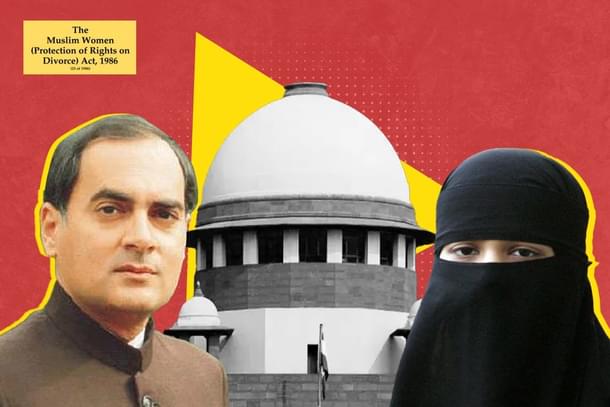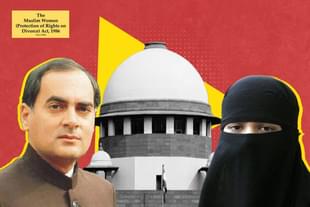Legal
Five Key Implications Of Supreme Court’s Judgement On Muslim Women’s Right To Maintenance
Abhishek Kumar
Jul 11, 2024, 07:27 PM | Updated 06:55 PM IST
Save & read from anywhere!
Bookmark stories for easy access on any device or the Swarajya app.


The Supreme Court has ruled that a divorced Muslim woman can ask for maintenance under Section 125 of the Criminal Procedure Code (CrPC).
Petitioner Abdul Samad had contended that his divorced wife could seek maintenance from him under Muslim Women (Protection of Rights on Divorce) Act (MWPRDA), 1986, instead of Section 125 of CrPC.
The court, however, rejected his argument.
Here are five key takeaways from the historic judgement.
MWPRDA, CrPC Complementary
One of the key contentions in the case was Section 3 of the 1986 Act. The section begins with the phrase "notwithstanding anything contained in any other law". This was being interpreted as overriding Muslim women’s rights under Section 125 of CrPC.
However, the intention behind and execution of the respective clauses of both CrPC and MWPRDA is the same — providing relief to divorced women. Since the principle is not in conflict, it is not a fitting case for precedence of Section 125 of CrPC over MWPRDA.
The apex court, in fact, held that the right way of reading MWPRDA is to see it as an addition to Section 125 of CrPC.
“The judgement reiterates what has been constantly held by the courts time and again. In the garb of giving something, you can't take away a right which is constitutionally guaranteed. A reading giving the 1986 Act precedence over Section 125 CrPC would have, in effect, meant violating Articles 14, 15(1), and 15(3),” Kumar Abhishek, an advocate practising at the Supreme Court, said.
Woman Beyond Other Classification
The intention behind Section 125 of CrPC was to enhance women’s social security without viewing them from the lens of religion, caste, clan, or anything else. Some societies do treat women as an independent entity, while others focus on setting boundaries around them.
For instance, when CrPC was introduced, voices of dissent stating that it might take Hindu women outside the religious umbrella were not heard. This was even after Hindu women had the option to seek maintenance under the Hindu Marriage Act.
This was not the case for Muslim women in the aftermath of the Shah Bano judgement — allowing Muslim women to claim maintenance under Section 125 of CrPC. For the conservative (and dominant) faction in the Muslim community, the Shah Bano judgement was the beginning of Muslim women getting free from the shackles of religious morality.
To assuage them, Rajiv Gandhi brought the MWPRDA in 1986 — an attempt to neutralise the Supreme Court's stand that Muslim women can claim maintenance under CrPC.
Both laws seek the same goals but vary in their original authority. While CrPC is largely rooted in the Fundamental Rights chapter of the Constitution — giving equal rights to women — the MWPRDA derives its authority from Shariat.
Talking about the latest as well as the previous decisions iterating the same, Kumar Abhishek, said, “All such decisions should be seen as sound restatements of the constitutional commitment to ensuring a gender-just society and the negation of notions considering women as chattels.”
Importance Of Maintenance, Autonomy For Muslim Women
Although the judgement holds both laws as complementary to each other, it does not bar women from using one act or another. So, a Muslim woman who is married and divorced under Muslim personal law, or even illegally divorced, can seek maintenance under the MWPRDA, CrPC, or both.
The only bar is for Muslim women who married under the Special Marriage Act (SMA) 1954. Because marriages under this Act are done without considering the religious identity, Muslim women marrying under SMA can’t claim maintenance under MWPRDA due to its religious nature.
The judgement reflects the apex court's understanding of the reality around the maintenance of women after divorce. In the last few years, a section of civil society is attempting to bring a change in maintenance laws in the country.
They contend that since women are becoming breadwinners, maintenance laws need to reflect that reality. However, the truth is that only a tiny section of urban women are earners.
The Supreme Cour has once again recognised the needs of rural women, who are among the most disadvantageous.
Regarding the need for maintenance, Abhishek said, “You can't see women through the limited few who are in gainful employment or vocations, especially in the urban setup. Destitution or separation brings tremendous hardships beyond our imagination — to the housewives in particular. Justice Nagarathna's concurring judgement is a great sociological elucidation of this. She holds that maintenance is a measure of parity, not charity.”
1986 Act Is Effectively Dead
In the backdrop of multiple judgements — the Danial Latifi case, Iqbal Bano case, Shabana Bano case, Shamima Faruqui case, and the latest case of Abdul Samad — MWPRDA is effectively dead for practical purposes.
Though the 1986 Act did not explicitly elaborate the intention behind it, prevalent political and logical wisdom is that it was originally brought to foreshadow Section 125 of CrPC.
The law did provide a recourse for Muslim women to seek remedy under CrPC, but lawmakers (read Rajiv Gandhi) of the day did not leave the decision in the hands of women.
Instead, to proceed under Section 125, the woman had to seek permission from her former husband. Now, a Muslim woman has the unilateral right to seek remedy under Section 125 of CrPC.
The other contentious aspect regarding the provision of maintenance only till the period of iddat has already been extended beyond that period in the Danial Latifi judgement.
With key provisions diluted till the extent of effective nullification, MWPRDA is now a toothless tiger.
Implications For Uniform Civil Code (UCC)
The whole idea behind a UCC is one set of laws becoming the basis of daily lives of every citizen who knowingly or unknowingly lives under the guidance of constitutional morality. It would be absurd if one community follows one law while another follows a different one.
In India, even a debate about this duality is shunned in the interest of ‘secularism’.
In February this year, the Uttarakhand government implemented UCC, the aftereffects of which are being studied by policy analysts and lawmakers.
Simultaneously, it is also true that in the wake of Bharatiya Janata Party (BJP) failing to attain a majority of its own, the UCC discussion seems to have been put on the backburner.
Through the latest pronouncement by the Supreme Court, an opportunity has once again arisen. The judgement is in line with the principles of UCC — treating equals as equals.
The government should not let this opportunity go begging.
Abhishek is Staff Writer at Swarajya.





